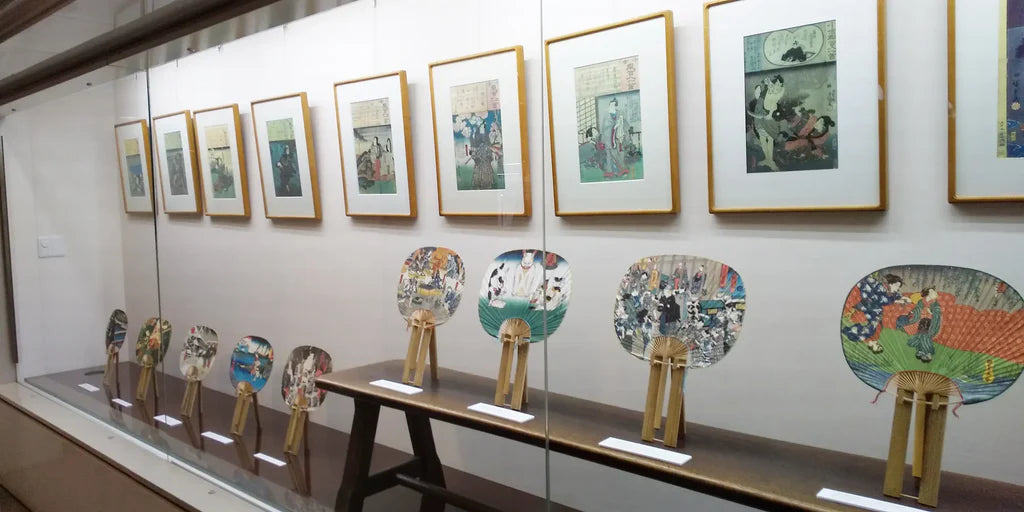Ukiyo-e Museum
On the first floor of IBASEN-Building is the Ukiyo-e Museum. Here, we hold seasonal exhibitions four times a year. We warmly invite you to visit and enjoy these displays of historical artistry.

IBASEN’s Ukiyo-e Prints
Ibasen originally operated as a “Hanmoto” (publisher), which can be likened to a modern-day publishing producer. Ukiyo-e prints were created using woodblock printing techniques. Ibasen commissioned designs from renowned artists like Kuniyoshi and Hiroshige for uchiwa illustrations. Over time, we began producing ukiyo-e prints alongside our primary business of making uchiwa. This dual role allowed us to contribute significantly to Edo-period art and culture.
Examples of Ukiyo-e Prints Produced by Our Company in Collections
Many ukiyo-e prints produced by IBASEN are now part of collections in renowned museums worldwide.
These include:
- The British Museum
- Museum of Fine Arts Boston
- The Metropolitan Museum of Art
- Van Gogh Museum
- Victoria and Albert Museum
- Ōta Memorial Museum of Art
The Spider Monster in the Mansion of Minamoto no Yorimitsu, by Utagawa Kuniyoshi (1797-1861). Print. Japan, 1843.
Allusion to the character Sanbaso, by Utagawa Kuniyoshi (1797-1861). Woodblock print. Japan, 1855.
An Actor in the Role of Chienai, central sheet of a triptych, by Utagawa Kuniyoshi (1797 - 1861), Edo, 1847-1850
Princess Izutsu, from the series Legends of Wise and Chaste Women, by Utagawa Kuniyoshi (1797 - 1861), Edo, c. 1842
Utagawa Kuniyoshi Exhibition at the Ōta Memorial Museum of Art, 2021, September 4th-October 24th
Highlights from Our Ukiyo-e Collection
Our collection includes various ukiyo-e prints that showcase the unique relationship between “Hanmoto” publishers and ukiyo-e artists during the Edo period. These works reflect the spirited defiance and humor of Edo culture—traits that embody the vibrant character of Edoites. We are committed to preserving these timeless works and sharing their charm with future generations.
「源頼光公館土蜘蛛作妖怪図 」
Yokai (Specters) by Tsuchigumo, the official residence of Minamoto no Yorimitsu, Utagawa Kuniyoshiho
1843 (Tenpō 14)

This print depicts Minamoto no Yorimitsu being tormented by demons conjured by the Earth Spider (Tsuchigumo). While there are many depictions of Yorimitsu’s legendary battle against Shuten-dōji, this one stands out as a puzzle. The pattern on Yorimitsu’s kimono resembles that of Tokugawa Ieyoshi, the 12th shogun, while the crests on the samurai beside him suggest Mizuno Tadakuni. Each demon in the background invites speculation about who they represent. This satirical critique of Mizuno’s restrictive Tenpō Reforms resonated with Edo citizens, who eagerly bought the print. Its publisher, Ibasen, withdrew it and destroyed the woodblocks to avoid punishment. Despite this, Ibasen and Kuniyoshi’s Utagawa school continued producing satirical works critical of the shogunate while maintaining their official status as government-approved publishers.
「荷宝蔵壁のむだ書」
Nitakara-gura Kabe no muda-gaki, Utagawa Kuniyoshi
Circa 1847 (Kōka 4)

After the Tenpō Reforms banned actor prints, artists and publishers found creative ways to circumvent censorship. This piece was presented as "graffiti," not ukiyo-e. Viewers could recognize kabuki actors like Utaemon, Kōshirō, and Baikō hidden in its playful imagery. At its center is a dancing cat with two tails (a nekomata), adding a whimsical touch. Known as *kugie* ("nail pictures"), these prints were scratched into woodblocks to mimic graffiti. Kuniyoshi’s signature appears alongside humorous phrases like "Everyone seems to be laughing." This ingenuity connects Edo-period satire with modern manga's playful spirit.
Recognition by Chūō City Machikado Museum
The Chūō City Machikado Museum, which highlights cultural resources from Chūō City’s 400-year history since Edo's founding, officially recognized this collection on January 31, 2012.
